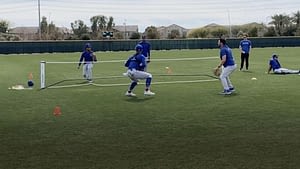Cheerleading: The Thrills, Spills, and How to Avoid Injuries
Cheerleading has evolved from being just an add-on to football games or pep rallies; it is now a highly competitive and physically demanding sport on its own. But here’s the kicker: this fun and flashy sport also carries some serious risks. While flipping in the air and executing precise stunts excites the crowd, cheerleaders are more prone to dangerous injuries compared to many other sports. So, how do you keep safe while throwing those perfect back handsprings and pyramids? Let’s dive into the world of cheerleading injuries, and talk about how athletes can protect themselves.
Why Is Cheerleading So Dangerous?
Catching everyone’s attention with dazzling moves and synchronized chants doesn’t come without a price. According to experts, cheerleading has some of the highest injury rates compared to other high school and collegiate sports. Many people are surprised to learn just how risky this sport can be. But when you take a step back and think about what’s involved—flying through the air, being lifted by your peers, or flipping upside down—it makes a lot of sense.
The National Center for Catastrophic Sports Injury Research found that 65% of all catastrophic injuries in high school female athletes come from cheerleading, a staggering statistic that raises eyebrows. And for those in collegiate-level cheerleading, the numbers don’t get much better. That means severe injuries that can result in permanent damage, or even death, are more common in cheerleading than you might expect.
What contributes to this danger? For starters, the kind of stunts that cheerleaders perform today are way more advanced than they were in the past. We’re talking demanding, dangerous tricks that often exceed the bounds of what most would expect from high school athletes. Add to that a lack of proper training or experience, and it can quickly become the perfect storm for serious injury.
The Types of Injuries Cheerleaders Face
It’s not just the complexity of stunts that increases the injury risk. It’s also the sheer variety. Cheerleaders can suffer from a range of injuries and, unlike other sports, they aren’t just limited to one part of the body like knees in soccer or shoulders in baseball. Injuries can affect everything, and we mean everything. Let’s break down the most common types of cheerleading injuries:
- Concussions: Arguably the scariest injury, concussions happen when a cheerleader’s head impacts the ground, another athlete, or even a piece of equipment. Symptoms can range from confusion and dizziness to more serious issues like memory loss or difficulty concentrating.
- Sprains and Strains: These soft-tissue injuries usually affect the ankles, wrists, and knees. They may be caused by sudden jerky movements or awkward landings from stunts.
- Fractures: Of all the hard-hitting injuries, fractures are the most dramatic to watch. Broken bones typically occur when a cheerleader falls from a height or is dropped while performing stunts.
- Dislocations: Shoulders and elbows are especially prone to dislocating in cheer. When these joints are forced out of place, they can bring on searing pain and may even limit mobility in the long term.
- Torn Ligaments: Perhaps you’ve heard of the dreaded ACL tear. This nightmare for athletes seems to affect cheerleaders just as much as other sports players. A torn ligament can require surgery and months of recovery before an athlete can return to sport.
Among these injuries, concussions and the damage they do to the brain steal the spotlight. Most people link them to football, but surprisingly, cheerleading has a high concussion rate too. Everyone can picture a cheerleader being gracefully tossed in the air, but unfortunately, sometimes that grace ends in disaster with a head-first fall to the gym floor. Even a split-second miscalculation can turn what appeared to be a routine stunt into something serious.
How to Prevent Cheerleading Injuries
So, what can cheerleaders, coaches, and parents do to keep things safe? No sport can be entirely free from injury, but there are definitely steps that can be taken to reduce the risks. If you or someone you know is a cheerleader, incorporating these injury prevention tips can make a huge difference.
- Start with Proper Training: Before even attempting advanced stunts, make sure every cheerleader has a strong foundation in gymnastics and basic tumbling. Always ensure that the coach is trained and qualified to teach the squad proper techniques.
- Use Protective Gear: Mats, braces, and guards can go a long way! Cheerleaders should practice their routines on mats to cushion potential falls. If the cheerleader has had a previous injury, wearing braces on weak joints can help prevent re-injury.
- Work on Flexibility: Stretch regularly to improve flexibility. Increased flexibility can help reduce the severity of injuries and, in some cases, prevent them. A well-stretched body can twist and react better in those tight cheerleading situations.
- Never Skip a Warmup: Cheerleading is intense. Before getting into any high-energy routines, spend time on a thorough warmup—at least 15 minutes of stretching and dynamic exercises to get the body ready.
- Focus on Spotting Techniques: Regularly practice spotting techniques until they become second nature. Readiness and anticipation are key in catching flyers or preventing bad landings.
- Limit High-Risk Stunts: Only attempt advanced stunts that the team has properly prepared for—and absolutely avoid anything higher than the cheer team’s skill level. Also, keep stunts within the guidelines specified by governing bodies.
A key element in cheerleading safety is enforcing proper progression. That means teams should build up their skillset slowly, not rush into dangerous moves. Too often, athletes attempt more than they’re ready for, which leads to an injury. Coaches should ensure that their athletes don’t skip steps in their training. If a skill isn’t perfectly safe on solid ground, it shouldn’t be practiced in the air.
The Role of Coaching & Leadership
A big part of making sure cheerleaders stay safe is having qualified coaches at the helm. Believe it or not, not every cheerleading coach is trained in safety protocols. If you’re a cheerleader considering joining a squad, or a parent of an aspiring cheerleader, it’s critical to find out how well-trained your team’s coaching staff is. It’s not enough to just know how to choreograph cool routines—coaches need to understand injury prevention and be able to recognize when a cheerleader needs to sit out.
Unfortunately, cheerleading doesn’t always have the same emphasis on safety training as other sports do. In many schools, football or basketball coaches are required to take sports safety and concussion training courses. But that’s not always the case for cheerleading coaches. This is a huge gap in safety, and it’s something more schools need to address.
An educated coach is not just about looking cool with a whistle around their neck—they’re key to making sure every routine is safe, and every athlete knows how to avoid injury.
What to Do if an Injury Happens
As prepared as anyone can be, accidents still happen. So, what should you do if an injury strikes? It’s crucial to recognize that not all injuries are visible. Sometimes, pain doesn’t set in immediately, or injuries like concussions can be masked by adrenaline. The body might be telling you to “shake it off,” but ignoring even small warning signs can make things worse in the long run.
Injuries should be treated immediately and seriously. Those moments of checking in, applying ice, and seeking out professional advice are essential pieces in ensuring an athlete heals properly. Here’s how to respond in the case of an injury:
- Listen to the Body: If something feels “off,” don’t push it. Pain, discomfort, or fatigue are all signals that something might be wrong.
- Ice the Injury: Icing can reduce swelling and numb the pain, which is crucial in those early moments after an injury.
- Call a Doctor: If it seems serious, don’t hesitate to get a doctor’s opinion—and that especially goes for head injuries. The quicker you know what you’re dealing with, the better.
- Follow the Recovery Protocol: You are no superhero, and rushing back into practice before fully healing could put you in danger of making the injury way worse than it was originally.
Cheerleading is Both Fun & Dangerous
Let’s be completely clear: cheerleading can be an incredibly fun, exciting, and empowering activity. But it’s important not to be oblivious to the risks that come with it. Injuries in any sport are possible, but in cheerleading, where the stakes are often higher and the stunts more complex, the likelihood of getting hurt is elevated. This doesn’t mean it’s time to hang up the pom-poms. It just means that with the right preparation, safety measures, and team awareness, cheerleaders can enjoy their sport without putting their health on the line.
So while you’re out there hitting those sharp motions, screaming chants from the rooftops, and working to perfect that tumbling pass, remember: safety always comes first. Let’s keep the squad soaring high—and landing safely.
Originally Written by: Heather Tucker





















